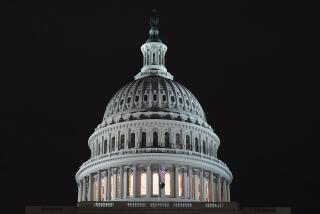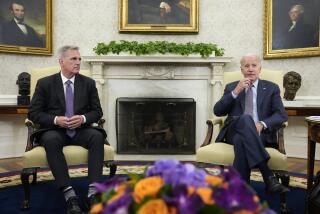Balanced Budget Agreement: A Lot of Faith in Guessing
- Share via
And now for the fine print. Democratic and Republican leaders are congratulating themselves and inviting the plaudits of the masses after reaching a broad if nebulous agreement to produce a balanced federal budget in five years. It’s necessary to go back through six presidencies, to Lyndon Johnson’s time, to find the last black-ink budget. To hail this latest achievement as an enduring breakthrough, however, might be embarrassingly premature. White House and congressional negotiators who foresee the end of an era when the government would routinely spend more than it took in base their optimism on economic assumptions that rest on shaky foundations. If those foundations crumble, the government would find itself right back in the familiar game of deficit financing.
The main assumption underlying the budget agreement is that economic performance over the next five years will pretty much mirror the performance of the last five years, which means steady and moderate growth, rising tax revenues and low inflation. That’s possible, but even a cursory glance at historical economic performance shows why it would be foolish to bet the house on it.
Currently, deficit reduction efforts are going splendidly. Last Thursday night, in an announcement that became the deal-maker in the budget negotiations, the Congressional Budget Office reported this year’s deficit will be an astonishing $45 billion below its earlier projection--once again underscoring the risk of putting too much credence in assumptions about what the economic future may hold. Projecting from this year’s good fortune that coming years will see $225 billion more in tax revenues than originally assumed could turn out to be another instance of what Federal Reserve Chairman Alan Greenspan has elsewhere labeled “irrational exuberance.”
Whether or not the latest revenue projections prove valid, a major congressional battle over how to implement the key components of the budget deal seems certain. Tax cuts promise to be the main arena of conflict. The next five years are expected to see a net tax cut of $85 billion ($135 billion in cuts offset by $50 billion in new revenues). How that will be apportioned among the capital gains and inheritance tax cuts the Republicans want and the education tax break and $500-per-child tax credit President Clinton is pushing remains to be determined. So too is how the Pentagon budget is to be cut by $75 billion over five years at a time when conservatives are demanding a lot more defense spending.
The budget conferees did nothing to deal with the systemic problems of Medicare and Social Security; in the case of Medicare they simply postponed for a few years the collapse of the hospital trust fund by cutting $115 billion in projected outlays to doctors and hospitals. Also untouched was the chance to correct the upward bias in the consumer price index, with a potential savings of hundreds of billions of dollars.
In the end, the budget deal satisfies what its authors see as the political needs of the moment. Whether it will also meet the nation’s economic needs depends on the accuracy of its assumptions, and how the complex details of the plan are fleshed out.
More to Read
Get the L.A. Times Politics newsletter
Deeply reported insights into legislation, politics and policy from Sacramento, Washington and beyond. In your inbox twice per week.
You may occasionally receive promotional content from the Los Angeles Times.










